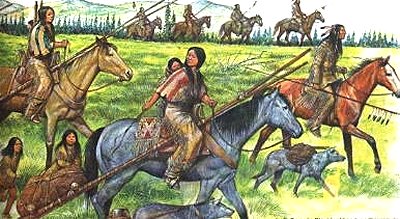1.In their attempt to besmirch this singularly great nation, the Left/Democrats have found truly inventive weapons to use.
The land itself.
The vastness, purple mountain majesties, and even the amber waves of grain, have all been weaponized.
Seems that a staple meme for the America-haters is ‘the land was stolen from the Native
Americans.”
Of course it wasn't.
The claim is one more example of
Rule #1
Every argument from Democrats and Liberals is a misrepresentation, a fabrication, or a bald-faced lie.
I’ve had enough…..so now I’ll destroy that smear.
2. We should never allow the Left to control the language, as they corrupt it. The American Indians were not ‘native’ to this continent. Any study of same….not government school….will prove that the ‘Indians’ migrated over the Bering land bridge from my home continent. The Asian visitors settled in the northwest, moved down the west coast, and on to South America.
It’s the reason Elizabeth Warren’s DNA showed some American Indian/South American evidence.
3.The appellation ‘native’ is useful for the Left as it allows them to paint those individuals as victims to the explorers/settlers/pioneers. If there were no ‘natives,’ then both sides had equal rights to the continent.
4. Next is the nature of the Indian societies. They were far from that bogus title the elites have awarded them: Nobel Savages.
They were simply savages.
These were stone age peoples, thousands of years behind the advancement of the settlers. They moved from one locale to another, using up resources, burning down entire forests, and slaughtering species to the point of extinction.
American Indians were almost certainly responsible for the extinction of many large mammal species:
Until ten thousand years ago an incredible bestiary of mammals roamed North America. These were the so-called mega-fauna, an exotic menagerie that included the woolly mammoth, saber-toothed tiger, giant sloth, giant beaver, camel, horse, two-toed horse,and dire wolf. These were the dominant fauna on this continent for tens of millions of years. Then suddenly and mysteriously they disappeared.
Alton Chase, "Playing God In Yellowstone," p. 100
"The Vore buffalo jump site in Wyoming...was used five times between 1550 and 1690,and holds the remains of 20,000 buffalo. That means 4,000 or more buffalo were killed each time the jump was used. Other buffalo jumps in the West display the remains of as many as 300,000 buffalo. These sites were so numerous, in fact, and held such large deposits of bone, that for many years they were mined as a source of phosphorus for fertilizer!"
Frison, G.C., "Prehistoric Hunters of the High Plains," pp.239-44
4. Why were they so cavalier, so thoughtless about the future?
Because the animals were there. Destruction was second nature, not consideration of the future.
That's pretty much the difference between said culture, and civilized examples.
The Europeans brought civilization to this continent.
Next…..the introduction of the concept of ‘property’….by those mean, horrid white folks….the ones the Democrat Party is targeting with their current version of racism.
The land itself.
The vastness, purple mountain majesties, and even the amber waves of grain, have all been weaponized.
Seems that a staple meme for the America-haters is ‘the land was stolen from the Native
Americans.”
Of course it wasn't.
The claim is one more example of
Rule #1
Every argument from Democrats and Liberals is a misrepresentation, a fabrication, or a bald-faced lie.
I’ve had enough…..so now I’ll destroy that smear.
2. We should never allow the Left to control the language, as they corrupt it. The American Indians were not ‘native’ to this continent. Any study of same….not government school….will prove that the ‘Indians’ migrated over the Bering land bridge from my home continent. The Asian visitors settled in the northwest, moved down the west coast, and on to South America.
It’s the reason Elizabeth Warren’s DNA showed some American Indian/South American evidence.
3.The appellation ‘native’ is useful for the Left as it allows them to paint those individuals as victims to the explorers/settlers/pioneers. If there were no ‘natives,’ then both sides had equal rights to the continent.
4. Next is the nature of the Indian societies. They were far from that bogus title the elites have awarded them: Nobel Savages.
They were simply savages.
These were stone age peoples, thousands of years behind the advancement of the settlers. They moved from one locale to another, using up resources, burning down entire forests, and slaughtering species to the point of extinction.
American Indians were almost certainly responsible for the extinction of many large mammal species:
Until ten thousand years ago an incredible bestiary of mammals roamed North America. These were the so-called mega-fauna, an exotic menagerie that included the woolly mammoth, saber-toothed tiger, giant sloth, giant beaver, camel, horse, two-toed horse,and dire wolf. These were the dominant fauna on this continent for tens of millions of years. Then suddenly and mysteriously they disappeared.
Alton Chase, "Playing God In Yellowstone," p. 100
"The Vore buffalo jump site in Wyoming...was used five times between 1550 and 1690,and holds the remains of 20,000 buffalo. That means 4,000 or more buffalo were killed each time the jump was used. Other buffalo jumps in the West display the remains of as many as 300,000 buffalo. These sites were so numerous, in fact, and held such large deposits of bone, that for many years they were mined as a source of phosphorus for fertilizer!"
Frison, G.C., "Prehistoric Hunters of the High Plains," pp.239-44
4. Why were they so cavalier, so thoughtless about the future?
Because the animals were there. Destruction was second nature, not consideration of the future.
That's pretty much the difference between said culture, and civilized examples.
The Europeans brought civilization to this continent.
Next…..the introduction of the concept of ‘property’….by those mean, horrid white folks….the ones the Democrat Party is targeting with their current version of racism.




